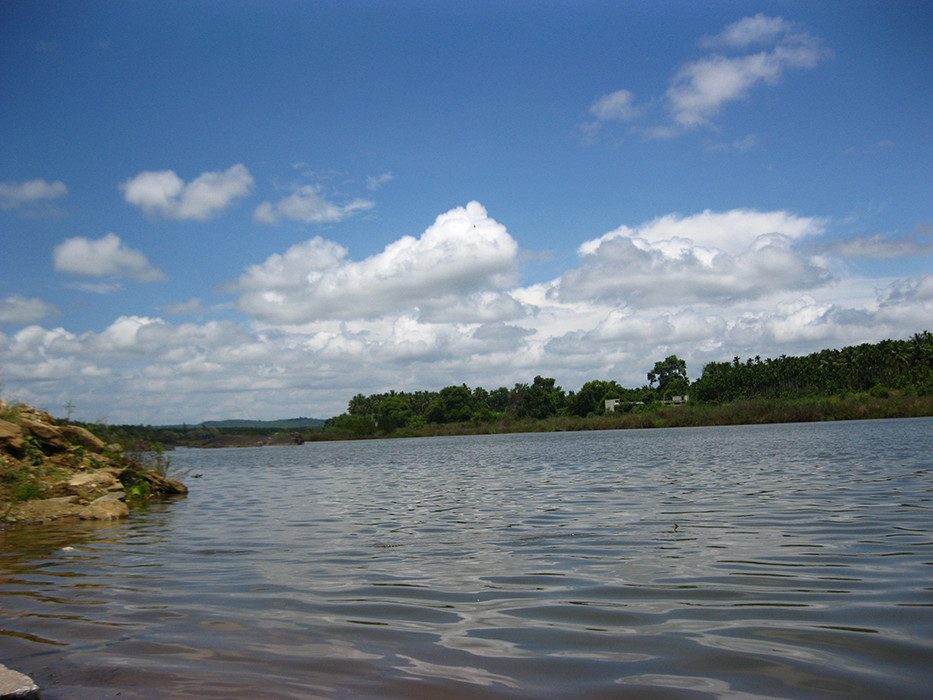Deepa Bhasthi pays a visit to the world’s only fully Sanskrit village, and finds that all that is, is not always that which is.
You know how you always miss what is right in front of you? That has been the classic case with me and this little village called Mattur. Let me first tell you why it is famous. Long, long back in school there was a talk that one Mr Mattur Krishnamurthy gave, about what I cannot remember now. Nice old man. The significance of the name of his village slipped away from memory for many years after that until an article in The Hindu featured the place. I remember vividly a photo alongside the words, of little boys with shaven heads but long tufts and in the traditional panche or sarong bent half atop a cricket bat, waiting intently for the bowler. The article venerated the last-man-standing drive with which the village of Mattur was conducting itself. For it was, as per the article, as per every Google entry I scanned through, the country’s—nay, the world’s—only fully Sanskrit village, where life was the way lives were led in the dusty old times of the raja-maharajas in the high-class ghettos or agraharas.
On my frequent trips to Shivamogga in central Karnataka, somehow the fact that this special village was a mere six kilometres away never came up. They say it is all about timing. And thus, when the timing was right, when I stayed an extra day, I found myself hard bargaining with an auto driver to take me to the village. Of course, all auto drivers are the same and I ended up paying the tourist price.
Two old men are lazily sprawled on what we call the chaavadi, a veranda of sorts in coastal homes, meant for cooling off in the hot afternoons before and after a heavy lunch to catch up with visitors and watch the world conduct its business. They look like they have been expecting me.
It is a pleasant ride; once past the houses and dust descending from whooshing cars and bikes, the road begins to be flanked by tall trees and green fields. It is June. The auto driver deposits me where the buildings in the village start. I hobble (nursing a sprained foot) along to where two old men are lazily sprawled on what we call the chaavadi, a veranda of sorts in coastal homes, meant for cooling off in the hot afternoons before and after a heavy lunch to catch up with visitors and watch the world conduct its business. The two men look like they have been expecting me. The village gets its share of tourists, several of them from other countries of the world, thanks to its prolific Internet profile.
I am soon dispatched to a school run by the Shri Sharada Shalabhivruddhi Samiti, at the edge of the village and told to meet one Shalini Teacher. They tell me that she will help me learn Sanskrit. I don’t correct their assumption. At the school, which houses the Samskrita Paatashala, Shalini Teacher, the one with a beautiful, welcoming smile, shows me to a small room where her colleagues sit. In a rapid alien tongue she tells me something I only comprehend because I see footwear outside the door: her instructions were to leave my shoes outside.
The three male teachers know why I am there; they get curious visitors like me and also get serious students at least twice every month. The headmaster, a grammarian, leaves for a class. Ramachandra and Ananthakrishna, who are experts in logic and conversational Sanskrit respectively, soon give me the lowdown on the village and its reputation. For a while, Kiran Avadhani, a scholar extraordinaire, who runs the traditional paatashala in the village, joins us.
Avadhani’s school teaches the Vedas, Upanishads and other religious texts to boys from Brahmin families. For six years, the boys live in the school, for free, in a gurukula system.
Avadhani’s school teaches the Vedas, Upanishads and other religious texts to boys from Brahmin families. For six years, the boys live in the school, for free, in a gurukula system and get trained, also learning basics of subjects like mathematics and science to help them get by in the world. Nearly all of them go on to become priests. Avadhani tells me that there are some fifteen students now, including one from out of state and others from around Karnataka. None are from the village. What he does not tell me is that the number of admissions to this gurukula has been steadily decreasing.
The other two teachers tell me that while the gurukula is open for only boys from the Brahmin community, the school is open for all. Though the school is a Kannada-medium one, every student is taught to read, write and converse in Sanskrit. Two girls playing tag are called in and asked to demonstrate for my benefit. My Sanskrit learning is limited to a first level in a correspondence course, half-heartedly completed a decade ago. I smile and nod and after some goading, attempt to string a sentence to answer where I am from when the girls ask.
Mattur is not only touted as the country’s only Sanskrit village, but also gives out the impression that Sanskrit is the aadu-baashe, the language of the streets, that you can hear it spoken over the counter at grocery shops, at street corners, by the river and elsewhere. That, exotic as it sounds, is not the case, I am soon informed. The assistant teacher Ramachandra tells me that Sanketi, a dialect that is part-Kannada, part-Malayalam and part a lot of other languages, is often taken as Sanskrit by wide-eyed visitors. Mattur has about 600 Sanketi Brahmins, a community that migrated from Kerala several generations ago and settled in the verdant environs of central Karnataka.
The assistant teacher Ramachandra tells me that Sanketi, a dialect that is part-Kannada, part-Malayalam and part a lot of other languages, is often taken as Sanskrit by wide-eyed visitors.
The reality, says Ramachandra, is that nearly all of them understand and speak in Sanskrit, and if he visits the village, they all converse in Sanskrit. But the grand old language is not exactly something you hear on the streets. Candidly, he admits that while the hype about Mattur is all true, it is just not the whole truth. A gold medalist in Sanskrit, from the pilgrim town of Sringeri, he tells me that they advise students to learn the language out of interest and to preserve it or such like, but never to make it a profession. “There is no money in it,” he rues. Avadhani makes do from the fees foreign students pay and once they leave after a month or two, gives them lessons over Skype. Ramachandra has a student in the USA; lessons are sometimes taken over half-hour phone calls. He tells me he wants to start these Skype lessons as well.
Ananthakrishna, the other assistant teacher, is from Tumakuru, a wee bit away from Bengaluru. A keen interest in the language made him learn and now teach it. He wants to learn journalism next and offers to send me his writings. I have to politely, and repeatedly, say no.
I don’t have much time to walk around the village and promise to be back. All my sprained leg lets me do is hobble along a lovely street, past a temple and down several steps to a river. She is the most gorgeous blue river, quietly shimmering past under an ultramarine sky. Wafting by is the sound of a dozen priests coordinating their chanting; there is some ritual making underway in a corner. Stripped off its religious rigidity and its many politics, chants tap into something primeval; it is so pleasant on the ear, I begin to think. Two stray dogs come by and leave. I dip my feet in the river. The water is cold, the lazy wind a bit warm. I take pictures, but not many.
None of the articles I read about Mattur spoke much of the river. But then it didn’t matter. All that is, is not always that which is.



